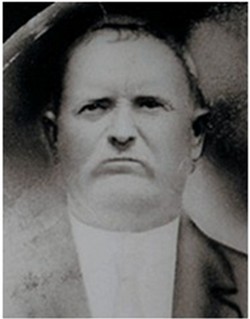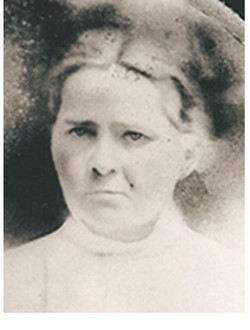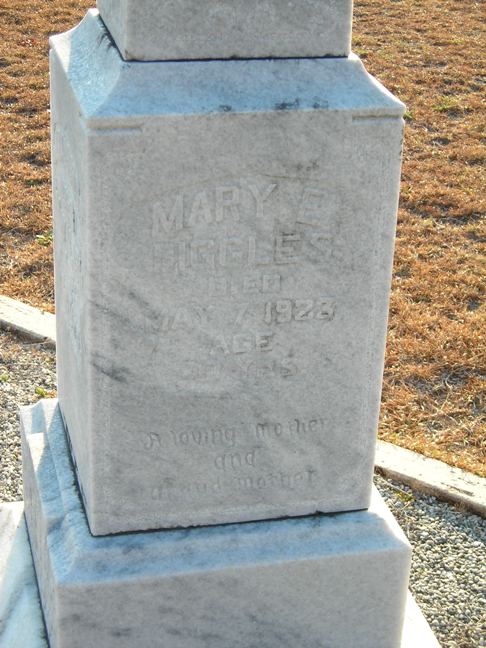Benjamin Thomas Allen was born February 23, 1852, at the Metcalfe community, near Thomasville, GA. He grew up during the Civil War and Reconstruction. In 1861 his father enlisted in a company from Thomasville known as the “Dixie Boys,” Company A, 57th GA Regiment and was sent to Savannah, GA but was discharged with pneumonia and came home sick in 1862. His father then secured a job as railroad section master which, as work essential to the war effort, exempted him from further military service.
In 1864, the family was at Johnson Station, now Ludowici, GA, where the Atlantic and Gulf Railroad had a stop referred to as “Four and a Half.” General Levi J. Knight, of Ray City, GA had been one of the original board members of the Atlantic & Gulf Railroad.
By the late 1860s, Benjamin Thomas Allen and his family were residing in Berrien County on the Nashville & Milltown Road about a mile east of Nashville, where he was likely attending the McPherson Academy. His older brother, Samuel D. Allen, was attending the Valdosta Institute in Valdosta, GA where he may have been a classmate of Matthew F. Giddens and John Henry “Doc” Holiday, who attended the Valdosta Institute during the same general time period. Sometime before 1870, the Allen family moved to Valdosta, and B. T. Allen, called “Bee Tree” by his friends, followed his brother in attending the Valdosta Institute.
He also attended the Fletcher Institute of Thomasville, GA, a Methodist boarding school and then one of the most prestigious high schools in Wiregrass Georgia. Hamilton W. Sharpe was one of the Lay Trustees for the school, which offered a “Course of Study [in] Orthography, Reading, writing, and Arithmetic,… with the higher branches of an English Education, embracing Natural, Mental and Moral Philosophy, Rhetoric Logic, Botany, Chemistry, Geology, Bookkeeping, and Political Economy,…Latin, Greek, French, Algebra, Geometry, Mensuration, etc —the object of which is to accommodate young men, who do not wish to go through College, with such a course as will enable them to enter upon any of the learned professions of this country.”
In Valdosta, B.T.’s father and brother worked for the Railroad, James Allen working as a Railroad overseer and Sam Allen working as a clerk. B. T. Allen was employed as a typesetter, probably for the South Georgia Times newspaper owned by Philip Coleman Pendleton. The Lowndes Historical Society notes, “In later writings B.T. Allen mentions his experience with the Pendleton’s and the Valdosta newspaper. In 1875 he played on Valdosta’s first baseball team.
In August of 1877, B. T. Allen was appointed City Clerk of Valdosta, Joseph J. Goldwire having resigned the position.
In the 1880 census [B.T. Allen] is living in Quitman and is listed as a printer.
In the 1890’s B. T. Allen was editor of the Tifton Gazette.
In the 1900 and after censuses he is living Pearson, Georgia with the occupation showing lawyer or lawyer/editor.”
As editor of the Pearson Tribune in the 1920’s Benjamin Thomas Allen wrote a series of stories about growing up in Wiregrass Georgia. He published a memoir of the Reconstruction in Berrien County, GA on May 21, 1920.
PEARSON, GEORGIA, FRIDAY, MAY 21,1920
MEMORIES OF THE LONG AGO.
Nashville Young People Attend Milltown School Closing.Monday the editor goes to the Press meeting at Nashville and Tuesday to the fish dinner at Milltown. These events, so near at hand, awakens in his memory afresh events of more than half a century ago. To be precise, it was in the Spring of 1867. In these events both Nashville and Milltown had a part.
At that time Milltown had a most excellent educational institution presided over by Elder O. C. Pope, who came to Milltown from Sandersville, Washington county, to be the pastor of the Baptist church and also principal of the School. He was a young benedict, of polished manner and thoroughly educated. He was a most competent instructor and created quite an admirable reputation for the Milltown school. His sister, Miss Virginia, was his capable assistant.
It was in the springtime, the latter part of May, the school was to have special closing exercises. The people of Milltown were putting forth every effort to make it, an event to be long remembered — I remember it as if it was yesterday.
Invitations had been sent to the young people of Nashville to attend this school closing. So arrangements were made whereby a number of Nashville’s girls and boys could go, among them my brother, Sam, [and] myself. My brother was just home from school at Valdosta and ready for an outing. But there was a dark obstacle in the way of brother and I going. Mother was practically an invalid at that time/a laundress could not be secured to put our underwear in condition for us to wear, and brother had about given up the trip and made his supposed disappointment known by his ill humor. This editor confesses he wasn’t as sweet as a peach over the prospects.
It was Wednesday morning prior to the eventful day, mother called me to her and said: “Son, I am sad over your apparent disappointment and want to suggest a way to overcome the obstacles. You’ve played the part of cook and housemaid all the year, suppose you try your hand at laundering. I believe you, with my instructions, can do the laundering all right.”
That afternoon I got busy; selected all the necessary pieces for brother and I, gave them a thorough washing and rinsing. The next morning, under the direction of mother I prepared the starch and starched the clothes and put them out to dry. That afternoon I dampened and ironed them. Mother all the while, was near at hand to explain every detail of the task. [Boys, never forget your mothers; they are your dearest friends on earth.]
To the average boy laundering does not appeal as a manly task, but I was proud of my first experience. Mother approved it as a real neat job. I was proud of it because it drove away disappointment and would please brother Sam, who was not wise to the effort I was making to overcome the obstacle in the way of the Milltown trip. Early Friday morning we were ready, looking just as trim and neat as any of the boys who made the trip.
Our home was about a mile east of Nashville and on the then Milltown road, and we were to be picked up on the way. There was three two horse wagons, furnished by Judges James F. Goodman, H. T. Peeples and E. J. Lamb, and when brother and I got aboard there was no room to spare. As I remember the party, the ladies were Mrs. McDonald, the widowed daughter of Judge Peeples, and her step daughter, Miss Virginia McDonald, Misses Helen, Carrie and Annie Byrd, Poena Goodman, Victoria Dobson, Lula and Mary Morgan, and Miss Simpson whose given name have escaped me; the gentlemen were Dr. H. M. Talley, Silas Tygart, John Goodman, Henry Peeples, W. H. Griffin, William Slater, Arthur and John Luke, brother and myself. It, was a jolly party, sure enough!
The party reached Milltown about 10 o’clock. The way we had to go it was seventeen miles from Nashville to Milltown. The school was housed in a large two story frame building, erected conjointly for a Masonic Lodge and School. The exercises had begun and the building or school room crowded to its utmost capacity.
At noon, a bountiful and splendid basket dinner was served on a lawn under some wide spreading oaks.
Very few of the country folks who lived closed by remained for the exhibition at night, so there was plenty of room in the auditorium and everybody got a seat. It was too far for the Nashville party to go home, they remained for the exhibition and were entertained for the night in the hospitable homes of Milltown. Brother and myself spent the night at the home of Elder Pope. Milltown, at that time, was an important trading point and had been for years. The people of the town and adjacent country were well to-do—-some of them wealthy —refined and cultured, and it was a delight to mingle with them. It was on this, my first visit to Milltown, I formed the acquaintance of Judge Lacy E. Lastinger, who has just celebrated his golden wedding anniversary; he was single then. Judge Lastinger’s father, William Lastinger, built the original Banks’ mill and created the mill pond from the waters of which the fish for the Editors’ dinner is to be caught. At the time of which I write he had already sold the property to Henry Banks, a wealthy North Georgian, and it is still the property of his estate according to my best information.
Related Posts:
- Owen Clinton Pope, Reconstruction Teaching and Preaching
- Judge Richard Augustus Peeples
- Lowndes Immigration Society, 1867
- Richard Augustus Peeples, Clerk of the Berrien Courts
- Matthew F. Giddens ~ Teacher, Businessman, Public Administrator
- The Booby Clift Affair in Valdosta
- General Levi J. Knight ~ Railroad Tycoon
- Joshua Berrien Lastinger

























